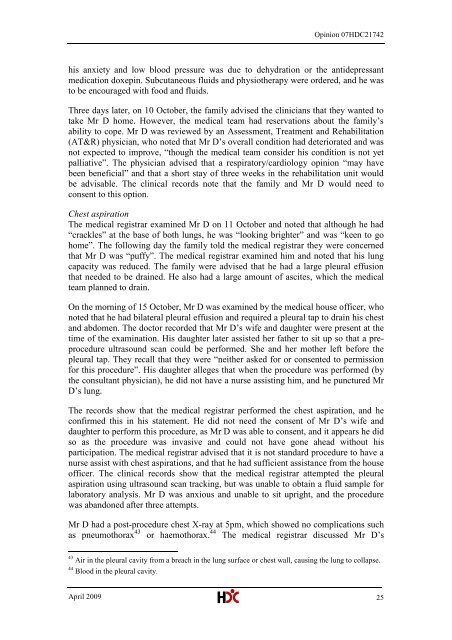North Shore Hospital report - New Zealand Doctor
North Shore Hospital report - New Zealand Doctor
North Shore Hospital report - New Zealand Doctor
You also want an ePaper? Increase the reach of your titles
YUMPU automatically turns print PDFs into web optimized ePapers that Google loves.
Opinion 07HDC21742his anxiety and low blood pressure was due to dehydration or the antidepressantmedication doxepin. Subcutaneous fluids and physiotherapy were ordered, and he wasto be encouraged with food and fluids.Three days later, on 10 October, the family advised the clinicians that they wanted totake Mr D home. However, the medical team had reservations about the family‘sability to cope. Mr D was reviewed by an Assessment, Treatment and Rehabilitation(AT&R) physician, who noted that Mr D‘s overall condition had deteriorated and wasnot expected to improve, ―though the medical team consider his condition is not yetpalliative‖. The physician advised that a respiratory/cardiology opinion ―may havebeen beneficial‖ and that a short stay of three weeks in the rehabilitation unit wouldbe advisable. The clinical records note that the family and Mr D would need toconsent to this option.Chest aspirationThe medical registrar examined Mr D on 11 October and noted that although he had―crackles‖ at the base of both lungs, he was ―looking brighter‖ and was ―keen to gohome‖. The following day the family told the medical registrar they were concernedthat Mr D was ―puffy‖. The medical registrar examined him and noted that his lungcapacity was reduced. The family were advised that he had a large pleural effusionthat needed to be drained. He also had a large amount of ascites, which the medicalteam planned to drain.On the morning of 15 October, Mr D was examined by the medical house officer, whonoted that he had bilateral pleural effusion and required a pleural tap to drain his chestand abdomen. The doctor recorded that Mr D‘s wife and daughter were present at thetime of the examination. His daughter later assisted her father to sit up so that a preprocedureultrasound scan could be performed. She and her mother left before thepleural tap. They recall that they were ―neither asked for or consented to permissionfor this procedure‖. His daughter alleges that when the procedure was performed (bythe consultant physician), he did not have a nurse assisting him, and he punctured MrD‘s lung.The records show that the medical registrar performed the chest aspiration, and heconfirmed this in his statement. He did not need the consent of Mr D‘s wife anddaughter to perform this procedure, as Mr D was able to consent, and it appears he didso as the procedure was invasive and could not have gone ahead without hisparticipation. The medical registrar advised that it is not standard procedure to have anurse assist with chest aspirations, and that he had sufficient assistance from the houseofficer. The clinical records show that the medical registrar attempted the pleuralaspiration using ultrasound scan tracking, but was unable to obtain a fluid sample forlaboratory analysis. Mr D was anxious and unable to sit upright, and the procedurewas abandoned after three attempts.Mr D had a post-procedure chest X-ray at 5pm, which showed no complications suchas pneumothorax 43 or haemothorax. 44 The medical registrar discussed Mr D‘s43 Air in the pleural cavity from a breach in the lung surface or chest wall, causing the lung to collapse.44 Blood in the pleural cavity.April 2009 25
















